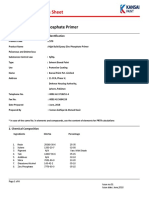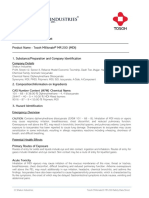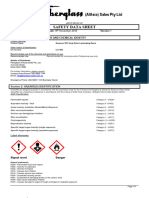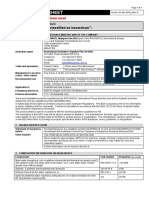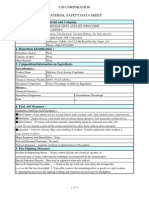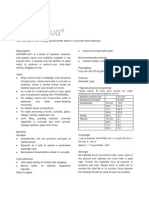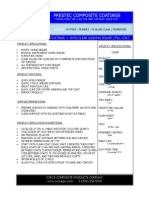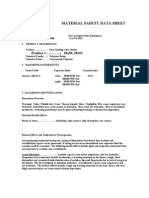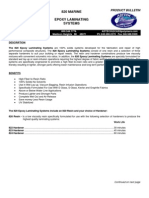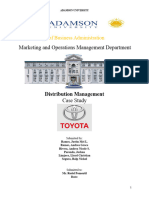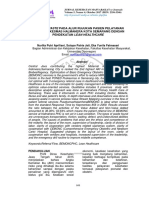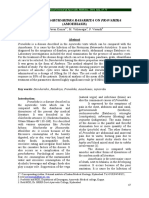820 Resin MSDS
820 Resin MSDS
Uploaded by
ajaldacoCopyright:
Available Formats
820 Resin MSDS
820 Resin MSDS
Uploaded by
ajaldacoCopyright
Available Formats
Share this document
Did you find this document useful?
Is this content inappropriate?
Copyright:
Available Formats
820 Resin MSDS
820 Resin MSDS
Uploaded by
ajaldacoCopyright:
Available Formats
Page 1 of 5 Revision Date: 08/14/07
MATERIAL SAFETY DATA SHEET
1. IDENTIFICATION OF THE SUBSTANCE/PREPARATION AND OF THE COMPANY
PRODUCT NAME: 820 Resin
CHEMICAL NAME: Bisphenol-A Epoxy Resin Blend
MANUFACTURER: CASS POLYMERS OF MICHIGAN, INC.
815 WEST SHEPHERD STREET
CHARLOTTE MI 48813 USA
INFORMATION PHONE: (248) 588-2270
EMERGENCY PHONE: (703) 527-3887(Call Collect)
2. COMPOSITION/INFORMATION ON INGREDIENTS
Health 2
Flammability 1
Physical Hazard 0
Hazard Codes: *=Chronic Hazard 0=Minimal Hazard, 1=Slight Hazard, 2=Moderate Hazard, 3=Serious Hazard, 4=Severe Hazard
Material Composition
EINECS/ELINCS
Component CAS.NO Percent
No.
Bisphenol A Based Epoxy Resin 25085-99-8 Polymer 80% - 90%
Dodecyl/tetradecyl glycidyl ether 68609-97-2 Polymer 10% - 20%
Hazardous Materials are required to be listed if present in concentrations of 1.0% or higher. Materials posing a possible Chronic
Health Risk are required to be listed at concentrations of 0.1% or higher. Materials listed in section 2 are not necessarily hazardous.
See section 8-EXPOSURE CONTROLS/PERSONAL PROTECTION, and section 11-TOXILOGICAL INFORMATION for complete
hazard/exposure limit information.
3. HAZARDS IDENTIFICATION
****Emergency Overview****
Moderate skin irritant. Mild eye irritant. Mild respiratory tract irritant. May cause skin sensitization.
.
EC Classification(s): Xi-Irritant
Risk Phrases: R36/38: Irritating to eyes and skin
R43: May cause sensitization with skin contact
(See Section 15-REGULATORY INFORMATION for complete risk phrases.)
ROUTES OF EXPOSURE
Eye Contact
Skin Contact
Ingestion
EXPOSURE STANDARDS
Exposure standards available for individual components only. See Section 8-EXPOSURE CONTROLS/PERSONAL
PROTECTION for more information. Maintain air contaminant concentrations in the workplace at the lowest feasible levels.
HEALTH HAZARDS
Moderate skin irritant.
Mild eye irritant.
Mild respiratory tract irritant.
May cause skin sensitization.
TARGET ORGANS
Skin
SIGNS AND SYMPTOMS OF EXPOSURE (Acute effects)
Contact with eyes may cause mild irritation and discomfort. Contact with skin causes irritation, redness and discomfort which
is transient. Inhalation of mists may cause irritation in the respiratory tract. Inhalation of vapors from heated material may
cause irritation in the respiratory tract. Coughing and chest pain may result.
SIGNS AND SYMPTOMS OF EXPOSURE (Possible Longer Term Effects)
Page 1 of 5 820 Resin
Page 2 of 5 Revision Date: 08/14/07
Repeated and/or prolonged exposure may cause allergic reaction/sensitization. Repeated and/or prolonged exposures may
result in: adverse skin effects (such as rash, irritation or corrosion).
MEDICAL CONDITIONS GENERALLY AGGRAVATED BY EXPOSURE
Skin disorders and Allergies
CARCINOGENS UNDER OSHA, ACGIH, NTP, IARC, OTHER
This product contains no carcinogens in concentrations of 0.1 percent or greater.
4. FIRST AID MEASURES
Never give fluids or induce vomiting if patient is unconscious or is having convulsions.
Inhalation
Move effected persons to fresh air; if effects occur, consult a physician.
Skin Contact
Continued and thorough washing in flowing water for at least 15 minutes is imperative while removing contaminated clothing.
Prompt medical consultation is essential. Wash clothing before reuse. Destroy contaminated leather items.
Eye Contact
Wash immediately and continuously with flowing water for at least 15 minutes. Remove contact lenses after the first 5
minutes and continue washing. Obtain prompt medical consultation, preferably from an ophthalmologist.
Ingestion
If swallowed, call a physician immediately. Remove stomach contents by gastric suction or induce vomiting only as directed
by a physician or medical personnel. Do not give anything by mouth to an unconscious person.
Note to Physician
No specific antidote. Treatment of exposure should be directed at the control of symptoms and the clinical condition of the
patient.
5. FIRE FIGHTING PRECAUTIONS
Extinguishing Media
Water fog or fine spray. Carbon dioxide. Alcohol resistant foam. Dry chemical fire extinguishers.
Hazardous Combustion Products
May generate toxic or irritating combustion products. Sudden reaction and fire may occur if product is mixed with an
oxidizing agent.
Protection of Firefighters
Wear positive-pressure self-contained breathing apparatus and protective fire fighting clothing (includes fire fighting helmet,
coat, trousers, boots and gloves.)
6. ACCIDENTAL RELEASE MEASURES
Personal Precautions
Wear adequate personal protective equipment, see Section 8, EXPOSURE CONTROLS/PERSONAL PROTECTION.
Methods of Cleaning Up
Large spills: Contain with dike. Pump into suitable and properly labeled containers.
Small spills: Dilute with water and recover or use non-combustible absorbent material/sand and shovel into appropriate
containers.
7. HANDLING AND STORAGE
STORAGE
Keep away from: oxidizers. Keep in cool, dry, ventilated storage areas and in closed containers.
HANDLING
Avoid contact with skin or eyes. Avoid breathing of vapors. Handle in well-ventilated workspace. When handling, do not eat,
drink, or smoke.
OTHER PRECAUTIONS
Emergency showers and eye wash stations should be readily accessible. Adhere to work practice rules
established by government regulations (e.g. OSHA).
8. EXPOSURE CONTROLS/PERSONAL PROTECTION
Hazardous Component Control Parameters –
Component CAS. No. EINECS Percent Exposure Limits Source
-No Data Available-
EYE PROTECTION
Chemical safety glasses. A full-face shield and vapor respirator is recommended for operations involving spraying or other
operations placing this material under pressurized conditions.
HAND PROTECTION
Neoprene rubber gloves. Impermeable gloves. Nitrile rubber gloves. The breakthrough time of the selected
Page 2 of 5 820 Resin
Page 3 of 5 Revision Date: 08/14/07
glove(s) must be greater than the intended use period.
RESPIRATORY PROTECTION
Not required under normal conditions and in a well-ventilated workplace. At elevated temperatures, a cartridge mask
National Institute for Occupational Safety and Health (NIOSH) approved for organic vapors may be appropriate
PROTECTIVE CLOTHING
Long sleeved clothing.
ENGINEERING CONTROLS
No specific controls needed. Heated material
WORK AND HYGIENIC PRACTICES
Provide readily accessible eye wash stations and safety showers. Wash at the end of each work shift and before eating,
smoking or using the toilet.
NOTICE: The selection of a specific glove for a particular application and duration of use in a workplace should also take into account
all requisite workplace factors such as, but not limited to: Other chemicals which may be handled, physical requirements (cut/puncture
protection, dexterity, thermal protection), as well as the instructions/specifications provided by the glove supplier.
9. PHYSICAL AND CHEMICAL PROPERTIES
Appearance : Mobile Liquid
Color: Off-White to Clear
Odor: Epoxy Odor
Specific gravity : 1.14 – 1.16
Vapor pressure: Not Determined
Boiling point/range : Not Determined
Freezing point/range : Not Determined
Water solubility : Liquid Components are Not Readily Soluble in Water
pH : Not Determined
Flash point : Not Determined
Auto-ignition temp. : >300 deg.C
Flammability-LFL : Not Determined
Flammability-UFL : Not Determined
% volatile: <1%
10. STABILITY AND REACTIVITY
CHEMICAL STABILITY
Stable
CONDITIONS TO AVOID (if unstable)
Not applicable
INCOMPATIBILITY (Materials to Avoid)
Oxidizing Agents (i.e. perchlorates, nitrates etc.). Sodium or Calcium Hypochlorite. Reaction with peroxides
may result in violent decomposition of peroxide possibly creating an explosion.
HAZARDOUS DECOMPOSITION PRODUCTS (from burning, heating, or reaction with other materials).
Carbon Monoxide in a fire. Carbon Dioxide in a fire. Irritating and toxic fumes at elevated temperatures.
HAZARDOUS POLYMERIZATION
Will not occur
CONDITIONS TO AVOID (if polymerization may occur)
Not applicable
11. TOXICOLOGICAL INFORMATION
Acute toxicity
This finished product has not been tested to determine individual toxicological/ecological limits. Individual components of
this mixture have been independently tested by the raw material manufacturers and any known results have been presented
below. The results for the individual components may not be representative of the toxicity of this finished product.
Ingredient Name CAS No. % Test Result Route Species
LD50 19.2 g/kg Oral Rat
Dodecyl/tetradecyl glycidyl ether 68609-97-2 10% - 20%
LC50 > 4g/kg Dermal Rabbit
-No Further Data Available-
Ingestion
This material has a low potential for toxic effects due to ingestion.
Skin Contact
Prolonged or widespread skin contact is not likely to cause toxic effects.
Page 3 of 5 820 Resin
Page 4 of 5 Revision Date: 08/14/07
Irritation
Skin
Skin contact has caused allergic skin reactions in certain sensitized individuals.
Eyes
May cause slight temporary eye irritation with local redness. Mechanical irritation possible due to solid filler materials.
Inhalation
May cause allergic respiratory response upon exposure to heated vapors.
Chronic Exposure
Carcinogen
This material contains no known or suspected carcinogens in levels above 0.1%
Mutagen
This material contains no known or suspected mutagens in levels above 0.1%
Reproductive Hazard
This material contains no known or suspected reproductive hazards in levels above 0.1%
12. ECOLOGICAL INFORMATION
Persistence/degradability
This material contains components that show little or no evidence of biodegradability. Caution should be taken to prevent
release to the environment. See Section 13 for disposal information.
Ecotoxicity Data:
Chemical Name CAS No. % Test Concentration Result Species
Bisphenol A Based Epoxy Resin 25085-99-8 80% - 90% LC50 3.1 mg/L* LC50 Fathead Minnow
* Toxicity effects are noted at concentrations above the level of normal water solubility
-No Further Data Available-
Individual components of this mixture have been independently tested by the raw material suppliers and any known results have been
presented above. The results for the individual components may not be representative of the ecological toxicity of this finished
product. This finished product has not been tested to determine individual toxicological/ecological limits Caution should be taken to
prevent release to the environment. See Section 13 for further information.
13. DISPOSAL CONSIDERATIONS
Disposal
The generation of waste should be avoided or minimized wherever possible. Preferred method of disposal includes
incineration under controlled conditions in accordance with all local and national laws and regulations. Untreated material is
not suitable for disposal. Waste, even small quantities, should never be poured down drains, sewers or watercourses. Waste
must be disposed of in accordance with federal, state and local environmental control regulations. This material, when
properly mixed and cured with its hardener component at the proper mix ratio, may be landfilled.
Contaminated packaging
Empty containers can only be disposed of when the remaining product adhering to the container walls has been removed.
Hazard warning labels should be removed from the container only after it has been properly emptied.
14. TRANSPORT INFORMATION
Land/Air/Sea/Rail
Proper Shipping Name: Liquid Plastic, NOI
UN Number: Not Regulated
Hazard Class: Not Regulated
Packing Group: Not Regulated
15. REGULATORY INFORMATION
US FEDERAL REGULATIONS
TOXIC SUBSTANCES CONTROL ACT (TSCA)-
All components are included in the EPA Toxic Substances Control Act (TSCA) Chemical Substance Inventory.
TOXIC SUBSTANCE CONTROL ACT (TSCA) 12(b) COMPONENT(S)
None
OSHA Hazard Communication Standard (29CFR1910.1200) hazard class(es)
Irritant. Sensitizer.
EPA SARA Title III Section 312 (40CFR370) hazard class
Immediate Health Hazard. Delayed Health Hazard.
EPA SARA Title III Section 313 (40CFR372) toxic chemicals above "de minimis" level are
None
Page 4 of 5 820 Resin
Page 5 of 5 Revision Date: 08/14/07
STATE REGULATIONS
PROPOSITION 65 SUBSTANCES (component(s) known to the State of California to cause cancer and/or reproductive toxicity
and subject to warning and discharge requirements under the "Safe Drinking Water and Toxic Enforcement Act of 1986")
None
NEW JERSEY TRADE SECRET REGISTRY NUMBER(S)
None
CANADIAN REGULATIONS
DSL
Included on Inventory.
WHMIS HAZARD CLASSIFICATION
Class D Division 2B- Skin Sensitizer
WHMIS INGREDIENT DISCLOSURE LIST
None
WHMIS TRADE SECRET REGISTRY NUMBER(S)
This product has been classified in accordance with the hazard criteria of the CPR and the MSDS contains all the
information required by the CPR.
None
WHMIS SYMBOL(S):
EUROPEAN ECONOMIC COMMUNITY (EEC)
EINECS/ELINCS MASTER INVENTORY
Included on EINECS inventory or polymer substance, monomers included on EINECS inventory or no longer polymer.
Xi
EU Labeling Classification: Xi-Irritant
Risk Phrases: R36/38: Irritating to eyes and skin
R43: May cause sensitization with skin contact
Safety Phrases: S24 Avoid contact with skin.
S37 Wear suitable gloves.
16. OTHER INFORMATION
Definitions:
ACGIH: American Conference of Government Industrial Hygenists
PEL: Permissible Exposure Limit
REL: Recommended Exposure Limit
TLV: Threshold Limit Value
TWA: Time-Weighted Average
LD50: Lethal Dose (50%)-The minimum dose required for lethal effects in 50% of a given population of test specimens.
LC50: Lethal Concentration (50%)- The minimum concentration required for lethal effects in 50% of a given population of
test specimens
NIOSH: National Institute for Occupational Safety and Health
WHMIS: Workplace Hazardous Material Information System
DSL: Domestic Substances List
To the best of our knowledge, the information contained herein is accurate. Final determination of the suitability of any material is the
sole responsibility of the users. All materials may present unknown hazards and should be used with caution. Although certain hazards
are described herein, we cannot guarantee that these are the only hazards which exist.
Page 5 of 5 820 Resin
You might also like
- Material Safety Data Sheet: Product Name: ABRO Electronic Contact Cleaner Product Number/Size: EC-533Document5 pagesMaterial Safety Data Sheet: Product Name: ABRO Electronic Contact Cleaner Product Number/Size: EC-533Abraham Gomez Soto100% (2)
- Extrepure Strong Acid Cationic ResinDocument1 pageExtrepure Strong Acid Cationic ResinWasis RakibNo ratings yet
- Karcher WD 3.330 Wet N Dry Vac ManualDocument5 pagesKarcher WD 3.330 Wet N Dry Vac Manualstinger30au0% (1)
- Material Safety Data Sheet CPO CARGILLDocument3 pagesMaterial Safety Data Sheet CPO CARGILLCarlos MontanoNo ratings yet
- N Spec 120 Cleaner Data SheetDocument11 pagesN Spec 120 Cleaner Data SheetSergio Alejandro Loza EscobarNo ratings yet
- Adhesive 820 MSDSDocument4 pagesAdhesive 820 MSDSDedi KartiwaNo ratings yet
- Spray Paint MsdsDocument4 pagesSpray Paint MsdsHillary RyanNo ratings yet
- Sparkle - Safety Data Sheet (SDS) - 2021 EngDocument4 pagesSparkle - Safety Data Sheet (SDS) - 2021 EngSophie TranNo ratings yet
- Eurapipe Abs Solvent Cement Material Safety Data SheetDocument19 pagesEurapipe Abs Solvent Cement Material Safety Data SheetClark Angelo JuanNo ratings yet
- Material Safety Data Sheet: KAN-HB Epoxy Zinc Phosphate PrimerDocument6 pagesMaterial Safety Data Sheet: KAN-HB Epoxy Zinc Phosphate PrimeroliviaNo ratings yet
- Msds Epoxy ResinDocument4 pagesMsds Epoxy ResinSrinivasan ReddyNo ratings yet
- Epoxy Resin Data SheetDocument9 pagesEpoxy Resin Data SheetDavid LazarNo ratings yet
- 05500Document6 pages05500khalid764No ratings yet
- Safety Data Sheet: 1. IdentificationDocument8 pagesSafety Data Sheet: 1. IdentificationJulián Herrera RestrepoNo ratings yet
- Isophthalic Resin - AROPOL IN 5334Document3 pagesIsophthalic Resin - AROPOL IN 5334GautamNo ratings yet
- Material Safety Data Sheet - Esyskimcoat Fine GreyDocument3 pagesMaterial Safety Data Sheet - Esyskimcoat Fine GreyJM Subion100% (1)
- MSDS Tile Grout SanitizedDocument2 pagesMSDS Tile Grout SanitizedDean Hadi WardanaNo ratings yet
- Eval Resin Sds (f101b)Document5 pagesEval Resin Sds (f101b)Bangun PrasetyoNo ratings yet
- Safety Data Sheet: A. Product NameDocument10 pagesSafety Data Sheet: A. Product NameSEONJONG PARKNo ratings yet
- MSDS - Super SM NeopreneDocument4 pagesMSDS - Super SM NeopreneAbdul Aziz Umar FananiNo ratings yet
- Ramset Anchoring Chemicals Reo502 PDFDocument1 pageRamset Anchoring Chemicals Reo502 PDFSuci YatiningtiyasNo ratings yet
- Chemistry and Composition of Epn ResinsDocument6 pagesChemistry and Composition of Epn ResinsDiana AndreiNo ratings yet
- Chockfast Orange Resin GhsDocument8 pagesChockfast Orange Resin GhsRizky RamadhanNo ratings yet
- MSDS PC 22 Radiator CoolantDocument4 pagesMSDS PC 22 Radiator CoolantAldiNo ratings yet
- Uniz Resin Spec PDFDocument11 pagesUniz Resin Spec PDFYerayNo ratings yet
- Safety Data Sheet: Hydroxyl-Terminated Polybutadiene (HTPB) ResinDocument6 pagesSafety Data Sheet: Hydroxyl-Terminated Polybutadiene (HTPB) Resinrajesh_rbpNo ratings yet
- MSDS Tosoh Millionate® MR 200Document7 pagesMSDS Tosoh Millionate® MR 200Raheel AsgharNo ratings yet
- Dowsil Glass Sealant Clear SDSDocument14 pagesDowsil Glass Sealant Clear SDSKissa DolautaNo ratings yet
- Revision Date: 00: Material Safety Data SheetDocument7 pagesRevision Date: 00: Material Safety Data SheetObbyNo ratings yet
- IT 990 Part.b PDFDocument16 pagesIT 990 Part.b PDFMohamed NouzerNo ratings yet
- 14.-Thread Cutting Oil Premium DarkDocument9 pages14.-Thread Cutting Oil Premium Darkluis armandoNo ratings yet
- Rep Prod j00519194 C 001 r01Document16 pagesRep Prod j00519194 C 001 r01Adriano CisterninoNo ratings yet
- Msds Cypergard 100 Ec Reg BaruDocument3 pagesMsds Cypergard 100 Ec Reg BaruFumigasi100% (1)
- C POL Resin PropertiesDocument2 pagesC POL Resin PropertiesSAURABH MODINo ratings yet
- FGA SDS Swancor 901Document8 pagesFGA SDS Swancor 901Denys C.O.No ratings yet
- Nitrogen MsdsDocument2 pagesNitrogen MsdsGangsar LukmanjayaNo ratings yet
- MSDS Jotun Pilot QDDocument13 pagesMSDS Jotun Pilot QDHaryanto RNo ratings yet
- Polyurethane Foam: Material Safety Data SheetDocument2 pagesPolyurethane Foam: Material Safety Data SheetAndriani Silfiana100% (1)
- Silica Flour MSDSDocument7 pagesSilica Flour MSDSizzybjNo ratings yet
- SDS NPK 15 15 15 EngDocument7 pagesSDS NPK 15 15 15 Engramachandran_chemNo ratings yet
- MSDS UV InkDocument4 pagesMSDS UV Inknorbertscribd0% (1)
- ROCKWOOL SDS Amd-11-Curr PDFDocument7 pagesROCKWOOL SDS Amd-11-Curr PDFr afriantoNo ratings yet
- MSDS EVA en UsDocument3 pagesMSDS EVA en UsbangsNo ratings yet
- MSDS - Chemofloc LT-27Document4 pagesMSDS - Chemofloc LT-27Barry ParkinNo ratings yet
- 306Document6 pages306vinithaNo ratings yet
- Bayhydur XP 2655 MSDS PDFDocument10 pagesBayhydur XP 2655 MSDS PDFrogerkid17No ratings yet
- MSDS Biowish AQUA FOG (STP)Document3 pagesMSDS Biowish AQUA FOG (STP)ijaysquerpantsNo ratings yet
- KMN SZ-7136 High Temp MSDS CartridgeDocument8 pagesKMN SZ-7136 High Temp MSDS Cartridgeufri.cavronglobalNo ratings yet
- Spin Prod 861787912 PDFDocument30 pagesSpin Prod 861787912 PDFCarmen PinizzottoNo ratings yet
- MSDS Petron Diesel MaxDocument5 pagesMSDS Petron Diesel MaxDomsNo ratings yet
- Damar ResinDocument3 pagesDamar ResinKukuh Satrio WibowoNo ratings yet
- 112 ColourbinderDocument7 pages112 ColourbinderArun StarlightNo ratings yet
- Msds - RInso CairDocument19 pagesMsds - RInso Cairyulia shinsungNo ratings yet
- 33 - TDS - Thoro WaterplugDocument3 pages33 - TDS - Thoro WaterplugOgbedande Awo OrunmilaNo ratings yet
- Msds Silicone 9045Document8 pagesMsds Silicone 9045Sanjeev ChughNo ratings yet
- Pom MSDS PDFDocument3 pagesPom MSDS PDFebercueNo ratings yet
- Msds en Shell Spirax s4 CX 50Document9 pagesMsds en Shell Spirax s4 CX 50EVCYNo ratings yet
- Umeguard SX White Cs-651Document12 pagesUmeguard SX White Cs-651Mugilrajan DevarajanNo ratings yet
- MSDS Contact CementDocument6 pagesMSDS Contact CementfaridanurroNo ratings yet
- Acetone Safety Data Sheet SDS PDFDocument10 pagesAcetone Safety Data Sheet SDS PDFkokoNo ratings yet
- Poly Sealer - Filler 28x50Document1 pagePoly Sealer - Filler 28x50ajaldacoNo ratings yet
- 28X50 MSDS Un1263Document5 pages28X50 MSDS Un1263ajaldacoNo ratings yet
- Poly Bondtec Isolator 20x50tsDocument1 pagePoly Bondtec Isolator 20x50tsajaldacoNo ratings yet
- 2000 Primers Msds Un1263Document5 pages2000 Primers Msds Un1263ajaldacoNo ratings yet
- 820 Series TDSDocument2 pages820 Series TDSajaldaco100% (1)
- 27x1 TDSDocument1 page27x1 TDSajaldacoNo ratings yet
- Prestec Comparison GuideDocument1 pagePrestec Comparison GuideajaldacoNo ratings yet
- Research EssayDocument11 pagesResearch Essayapi-559238330No ratings yet
- Standards For Evaluation and Eligibility Determination SEEDDocument40 pagesStandards For Evaluation and Eligibility Determination SEEDllollolloNo ratings yet
- Unit 7: Medical Frontiers Task 1: Read The Following Text and Answer The Questions BelowDocument3 pagesUnit 7: Medical Frontiers Task 1: Read The Following Text and Answer The Questions BelowphuonglinhNo ratings yet
- FAQ Teleworking Scheme Oct 2021Document17 pagesFAQ Teleworking Scheme Oct 2021Leonidas GalanisNo ratings yet
- PT Referral 1Document1 pagePT Referral 1raad_alghamdi_1No ratings yet
- Emotional IntelligenceDocument15 pagesEmotional IntelligenceIanne Sandra Sorrosa50% (2)
- BFA FullDocument9 pagesBFA Fullhistory APNo ratings yet
- Tuberculosis BCG VaccineDocument16 pagesTuberculosis BCG VaccineQworldNo ratings yet
- Running Head: BEING THE CHANGE 1Document4 pagesRunning Head: BEING THE CHANGE 1api-384327266No ratings yet
- English For AnalystDocument51 pagesEnglish For AnalystChitraNo ratings yet
- Adobe Scan 20-Jul-2021Document1 pageAdobe Scan 20-Jul-2021Annapoorna KanajeNo ratings yet
- Tourism in Kuwait: How This Country Is Trying To Face This DifficultyDocument2 pagesTourism in Kuwait: How This Country Is Trying To Face This DifficultyAouniza AhmedNo ratings yet
- Factors Influencing The Attitude and Practice of Nurses Towards Prevention of Nosocomial Infection in Lagos State University Teaching Hospital, Ikeja Lagos State.Document49 pagesFactors Influencing The Attitude and Practice of Nurses Towards Prevention of Nosocomial Infection in Lagos State University Teaching Hospital, Ikeja Lagos State.IJMSRTNo ratings yet
- Zambia Sugar PDFDocument7 pagesZambia Sugar PDFNicholas M BandaNo ratings yet
- Assessment Nursing Diagnosis Outcome Nursing Interventions Evaluation Standard Criteria Subjective: Short Term GoalDocument6 pagesAssessment Nursing Diagnosis Outcome Nursing Interventions Evaluation Standard Criteria Subjective: Short Term GoalmitchNo ratings yet
- Muscle Stretching Exercises and Resistance Training in Fibromyalgia: Which Is Better? A Three-Arm Randomized Controlled TrialDocument8 pagesMuscle Stretching Exercises and Resistance Training in Fibromyalgia: Which Is Better? A Three-Arm Randomized Controlled TrialDariusNo ratings yet
- Thesis Amos Group 4Document36 pagesThesis Amos Group 4Asnor TanggoteNo ratings yet
- Case Study Group1 (Toyota)Document22 pagesCase Study Group1 (Toyota)Andrea RamosNo ratings yet
- Luyện Cloze TestDocument63 pagesLuyện Cloze TestAnh Tuong MinhNo ratings yet
- Oxytocin and Ergot DerivativesDocument36 pagesOxytocin and Ergot Derivativesrevathidadam55555No ratings yet
- Clinical Decision Making in The ICU Dysphagia Screening Assesment and TreatmentDocument18 pagesClinical Decision Making in The ICU Dysphagia Screening Assesment and TreatmentΜαρία ΧανιωτάκηNo ratings yet
- PUSKESMASDocument11 pagesPUSKESMASVhini RvNo ratings yet
- Doc-20240131-Wa0 240131 225013Document2 pagesDoc-20240131-Wa0 240131 22501322alhumidi2020No ratings yet
- EmpathyDocument13 pagesEmpathyfabriciovicNo ratings yet
- Creating A Work Climate That Motivates Staff and Improves Performance PDFDocument26 pagesCreating A Work Climate That Motivates Staff and Improves Performance PDFzetabro1No ratings yet
- Outline & Evaluate Bowlby's Maternal Deprivation HypothesisDocument2 pagesOutline & Evaluate Bowlby's Maternal Deprivation HypothesisJames WoodNo ratings yet
- Toolbox Talk Form 2024Document3 pagesToolbox Talk Form 2024mohdfarhanbapNo ratings yet
- Rasanjana For PrabahikiDocument7 pagesRasanjana For PrabahikiVaidya NurNo ratings yet
- Fundamentals of Pharmacognosy & PhytotherapyDocument2 pagesFundamentals of Pharmacognosy & Phytotherapysafa_saba33% (9)
- QSAI Food Processing Quality (FPS) Standards & Interpretation Guidelines (2018)Document87 pagesQSAI Food Processing Quality (FPS) Standards & Interpretation Guidelines (2018)shofa.rahmannisaNo ratings yet









